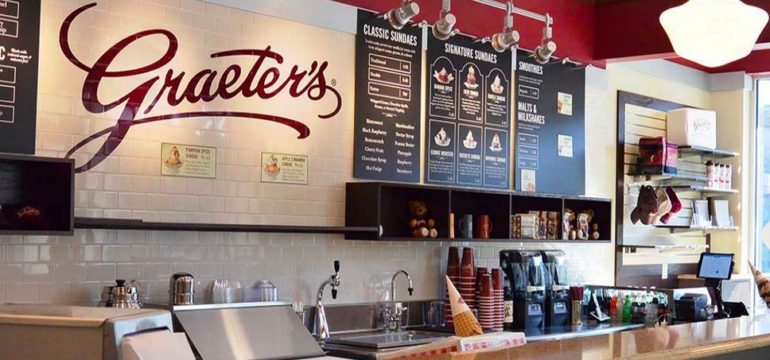BY: MACKENZIE HANNUM & ALEX PIERCE-FELDMEYER
Many of us have a memory of convincing our parents to take us out for ice cream. We would stand with our face and hands on the glass window case, admiring all the colors and flavors, eventually settling on the bluest ice cream. The ice cream attendant would hand us our cone and we would take it in with awe-struck eyes. Eventually our hands were covered in melted ice cream that was dripping to the floor but we still had a big smile on our face. Or maybe you and your classmates would gather at the nearest Graeter’s after the 8th grade dance lets out like Mackenzie or after every football game like Alex. We all likely have a blissful memory associated with ice cream. You might be a die-hard cookies and cream connoisseur, or swear by mint chocolate chip. Maybe your go-to is the classic vanilla. If you are from Ohio, or at least the Midwest, then your flavor is likely Graeter’s Black Raspberry Chip, which leads us to Bob Graeter, a childhood hero. It is Bob’s family (4 generations!) that is behind the majority of those memories that both Alex and I made growing up. Recently, after meeting at an OVIFT Networking Event, we had the privilege to interview him. Bob Graeter is currently the Vice President and Owner of Graeter’s Ice Cream and Manufacturing Co. It is our Midwesterner honor to share Bob Graeter’s perspective on the ice cream industry and his ever-changing role in product development.
History of Graeter’s Ice Cream
The Graeter’s Ice Cream Company was started in 1870 by Louis Graeter in Cincinnati, OH. Louis’ wife, Regina, helped to maintain the ice cream business with sons, Wilmer and Paul. They continued to sell ice cream throughout the Great Depression and World War II, bringing a necessary reprieve from current events. It is believed that Wilmer sneakily poured chocolate into the iconic French pot of ice cream, leading to the invention of Graeter’s signature chocolate chips that is a desired aspect of their ice cream today. As the baby boom era passed, the next generation including Dick, Lou, Jon and Kathy continued the family tradition. Into the 1980’s Graeter’s opened more franchises around the Ohio river valley and began selling pints from the Kroger Co. grocery stores. The 1990’s saw more expansion and Graeter’s began shipping ice cream all over the country. The current and 4th generation of the Graeter family, Bob, Chip and Richard, eventually took over the family business. To this day they balance maintaining the tradition of Graeter’s ice cream while emphasizing innovation. Graeter’s still makes ice cream in two-gallon batches with French Pot freezers that they began with and hand-pack every pint!1
We were lucky enough to speak with Bob about growing up in the family business, his career track, and his ever-changing role as a product developer.
As a child, Bob didn’t have a ‘grand plan’ for his future. But he was always curious and thought of himself has someone that appreciated science. Bob was quick to point out that working hard was central to his family culture. Within his household there was pressure to be a part of the family business from an early age, but he wasn’t too keen on working in the family business when he was young since he preferred to be outside playing with his friends. Before finding himself drawn to his current role in the company, Bob was interested in the world outside of ice cream and enjoyed learning about how things worked, whether it be in science, math or technology. He would try to learn as much about everything as he could, and at the time was not officially introduced to food science. In the 70s, during his college years, there wasn’t much formal education in food science like we know today (product development…etc.). Historically Bob remembers food science being more agriculture driven. He graduated from Wittenberg University with a B.S. in Biology and later pursued a Master’s in Business Administration from the University of Michigan. It wasn’t until 2017, after working at Graeter’s for 27 years, that he decided to obtain a Certified Food Scientist credential (CFS) from IFT to broaden his knowledge base and validate the knowledge he has accumulated over the years. Now he asks all the kids, “Why are you not studying food science? Everyone likes to eat – people will always buy food. There is always a job for a food scientist. You can have a guaranteed job – a fun job – a good career.”
Bob agrees there will always be jobs in the food industry but roles in growing companies change a lot over the years. Initially at Graeter’s, each employee was more of a ‘jack-of-all-trades,’ but over time more specialized roles were created:
“Specific manufacturing people, specific processing people, specific quality people, specific people for our distribution, sales, marketing, administration…We’ve grown a lot and filled out our team to make it more sustainable because no one can do everything.”
Bob says he used to do much more general work but now with specialized roles and more employees he can focus on product development and ingredient sourcing only. His primary activities include developing new flavors and working with vendor partners to source ingredients.
How do you get a new flavor in the Graeter’s lineup?
“First, a new flavor needs to work in our system.”
At Graeter’s, they don’t handle the raw main ingredients, like milk fat, solids, and sugar. Instead the main ingredients are received safely pre-processed, as a mix. This ice cream base is what they add things to, like flavor, color, and inclusion pieces (for example, milk chocolate caramel truffle pieces in Chunky Chunky Hippo!). Bob will personally come up with recipes and work with the marketing and retail team to review concepts. Eventually they will run trials of 5-8 flavors for the leadership team in a weekly meeting of owners, and top-level management for sales, marketing and manufacturing, to see what resonates with them and what they suspect works in the market right now. They also consider what other chefs or ice cream companies are doing, as well as what’s trending. If everyone agrees it has potential, they will bring it out as a seasonal or bonus flavor in their retail locations first. If it sells well, then it could become its own pint and move to grocery stores as part of the seasonal or regular lineup.
An interesting point Bob noted was that different flavors cost different amounts to produce depending on the ingredients sourced for the flavor. This might be due to unique inclusions (cookie dough, toffee), however, the cash register is blind to what ice cream you are buying. All scoops are the same price. All pints are the same price – regardless of the flavor. For example, one new flavor introduced in 2016 was Cheese Crown (https://www.cincinnati.com/story/entertainment/dining/2016/03/01/new-graeters-flavor/81118018/). This flavor concept was built from a well-known Cincinnati pastry known as a Cheese Crown and was Graeter’s first flavor to incorporate cheese. But how does Graeter’s know if a flavor will last?

Source for Ice Cream and Cream Puff Images
How do you measure success of a new flavor? When do you make the decision to turn it into a pint or full-time flavor?
Graeter’s relies mainly on their retail team feedback – what are customers buying? What are they sampling? More often than not customers buy the new flavor once, but then next time return to their classic.
“In the ice cream business – having variety allows you to generate media buzz and engagement with your customers. It starts a dialogue and a conversation. We have invested in more staff to help engage with our customers on that level.”
Most of their information on success comes from their 55 retail stores. These are their test markets and compliment their grocery store sales. First, they launch a new flavor in the stores, but if it does not sell well in the stores then they pull it before they invest in launching it to the grocery market. This is, unfortunately, the reason Cheese Crown no longer exists (R.I.P.). However, when a new flavor is successful, they will expand and manufacture it in pints. This is actually a relatively inexpensive way for customers to try a different flavor, but for Graeter’s, grocery stores are a more competitive space due to the volume and velocity of product sales required, and for them it is a more costly endeavor to launch a new flavor.
One of the more outstanding aspects of Graeter’s is that they are willing to create a new flavor even if it is not cost efficient, an exceedingly rare quality in a for-profit company. While many companies wouldn’t dare create something that did not have a comfortable profit margin, Bob really emphasized how much they enjoy their industry, saying sometimes the new flavor is just fun. Passion sometimes beats business logic and the flavor is released within retail locations.
“New flavors allow us to engage with our customers. They give us buzz and something to talk about – which essentially is free PR.”
That doesn’t mean the flavor will stay forever but they allow a new fun flavor to excite customers with the intention to eventually stop producing it, much like seasonal varieties of grocery store products (pumpkin spice!).
What are your thoughts on the influx of all the start-up companies with people who do not necessarily have a food science background?
For every company, like Graeter’s, rich in tradition and history, there are countless start-ups that break into the ice cream space without much experience, but many have made big waves.
Halo Top’s success is a notable example – one that has driven a lot of the startup movement within the ice cream sector. It is not real ice cream, though it is sold like ice cream. In reality it’s a protein drink replacement. Halo Top found a tremendously successful niche that allowed them to expand quickly as it was really hot among consumers.
Bob is not surprised or worried about this though. He says, “This really happens a lot in the ice cream space. The barriers in ice cream are really low so it is possible to do it…having long term success is really different. We have our own retail stores – so we are in a sense in control of our own destiny and our long-term success.”
“We are a real small niche business. We’re not apologizing for this creamy, handmade, artisanal ice cream. People will alternate between brands, products, and soft-serve all the time, depending on their mood. Other times you might want really indulgent ice cream. At Graeter’s, we want to be the best of the best quality and appeal to our customers. ”
Graeter’s stays true to their brand, focusing on bringing the best quality to their customers.
Bob goes on to perfectly describe what makes Graeter’s, Graeter’s.
“It’s not just ice cream, it is the experience. Graeter’s stores are a nice place to go and spend time with family, but then we also have great ice cream
“For some customers the flavors bring them to Graeter’s. For others, it might be something else.”
“It is so segmented out – there are so many different choices people are making when they come to a store.”
Bob is the first to admit that Graeter’s is an indulgent ice cream, – “high fat, high sugar, no air – full of all the good stuff.” As they’ve grown over the years, they have scaled up non-differentiating aspects of their process but have kept what makes Graeter’s high quality and unique all the same: hand packing pints using the French Pot method to keep the ice cream famously creamy and chock full of chocolate chips. They are not savory or edgy in terms of flavors like some other chains. But they differentiate well. Though it is a laborious process (hand packing 5 million pints a year!), it is what sets their ice cream apart. At their core, their brand is a hand-made product.
*Want to learn more about the French Pot process? Click here.
What advice do you have for budding food scientists?
Bob was also not short on great advice for younger generation Food Scientists. He emphasized getting real-world experience and learning how to make something from start to finish. His advice truly reflected his innate childhood curiosity in how the world around him worked. He made sure to emphasize that we, as budding Food Scientists, need to “get out of the theoretical and get into the practical.”
“Work in industry making something – see how something is made and put together outside of a lab. How does it flow, how is it distributed, what is the marketplace? Get beyond the science and into the production.”
And in case you were wondering if Bob had any more food interests, he does! Bob is an avid wine collector, a self-proclaimed wine geek. Wine, to Bob, is the embodiment of food and culture. He believes the wine and food of a region are symbiotic with one another. With Bob’s family history, I think it is safe to assume he understands how to appreciate food and culture. Wine and ice cream are also our two favorite food items!
Thank you, Bob, for allowing us to learn about the Graeter’s family history and tradition! It is safe to say that after talking about Graeter’s ice cream that we both made an immediate visit to a retail store to check out some of their new flavors, in the name of research for this blog post of course. The passion for this product is too GRAET to pass up and may everyone keep eating GRAET ice cream (we recommend the black raspberry chip!).
(P.S. Come check out our Instagram and Facebook for more weekly IFTSA updates, news, and food science!)
References:








4qi9Hw3p